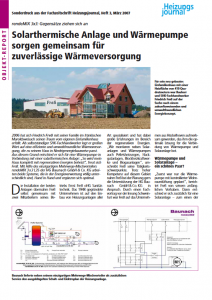Solar thermal system and heat pump together provide reliable heat supply
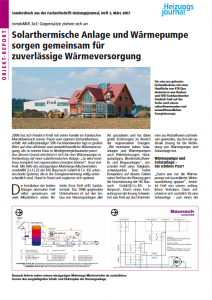 In 2006, Friedrich Freß and his family fulfilled their dream of owning a single-family home in Maroldsweisach, Franconia. As a self-employed sanitary, heating and air-conditioning specialist, he attaches great importance to an efficient and environmentally friendly heat supply that suits his low-energy house. For this reason, he decided on a heat pump in combination with a solar thermal system: "This way, my house is heated completely with renewable energies," says Freß happily. With the help of the unique multi-way mixing manifold rMIX 3 x 3 L 35 of HG Baunach GmbH & Co. KG, both systems, which are completely different in terms of energy utilisation, work hand in hand and complement each other optimally.
In 2006, Friedrich Freß and his family fulfilled their dream of owning a single-family home in Maroldsweisach, Franconia. As a self-employed sanitary, heating and air-conditioning specialist, he attaches great importance to an efficient and environmentally friendly heat supply that suits his low-energy house. For this reason, he decided on a heat pump in combination with a solar thermal system: "This way, my house is heated completely with renewable energies," says Freß happily. With the help of the unique multi-way mixing manifold rMIX 3 x 3 L 35 of HG Baunach GmbH & Co. KG, both systems, which are completely different in terms of energy utilisation, work hand in hand and complement each other optimally.

Fig. 1: For his newly built single-family home with a heating surface of 410 square metres, builder and SHK craftsman Friedrich Freß was looking for a forward-looking and environmentally friendly energy concept.
Freß installed the two systems himself together with two employees from his company. Ernst Freß oHG Sanitary engineering. The company, founded in 1948, specialises in the installation of all kinds of heating systems and has extensive experience in the field of renewable energies. "In addition to solar systems and heat pumps, we also install pellet heating systems, wood chip systems, combined heat and power plants and biogas systems," says Freß, describing his main activities. Despite his high level of expertise in this field, Freß was happy to call on the support of HG Baunach GmbH & Co. KG during the planning phase. Freß had become aware of the company from Hückelhoven through a technical lecture to the Schweinfurt guild, which offered him the optimal solution for combining a heat pump and a solar system.
Heat pump and solar system - a nice pair?
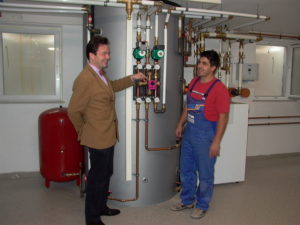
Fig. 2: Service included: Hans-Georg Baunach (left), head of the company of the same name and inventor of the rendeMIX, convinces himself on site of the correct functioning of his heating concept, which was individually developed for Friedrich Freß (right).
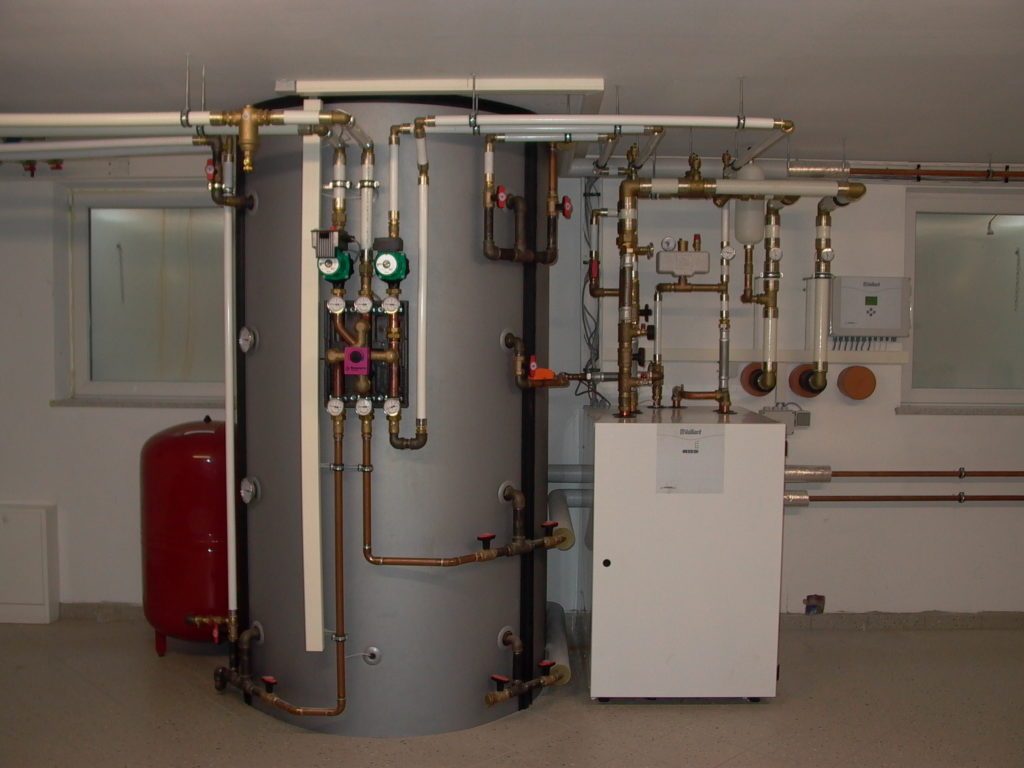
Fig. 3: The heating system: A solar system measuring over 40 square metres with a 2,000-litre buffer storage tank and a heat pump provide the Freß family's house with the heat it needs in a reliable and environmentally friendly way.
"At first, only the heat pump with controlled ventilation of the living space was planned," Freß reports about his initial project. Then he decided to add a solar system - for the sake of the environment on the one hand, and as a reference for his own customers on the other. The key question he then revolved around during the planning process was how to combine the two systems in a sensible way without them interfering with each other and impairing their effect. Because while a heat pump has a large volume flow with a small spread (5K), the buffer storage connected to the solar thermal system works exactly the opposite way with a low volume flow and large spread. The solar system absolutely needs low return temperatures for efficient energy production. Only in this way can it make a significant contribution to heating support in winter. The heat generated by the solar system is layered in a buffer storage tank in such a way that the hottest water is always stored at the top and the coldest at the bottom. In this way, mixing does not occur and both high and low temperatures are available. If the heat from the heat pump were also to be stored in the buffer storage tank in the configuration that Freß had planned, this would destroy the sensitive temperature stratification: it was therefore necessary to prevent the heat pump from mixing the buffer storage tank, which is supported by a stratified charging module, in such a way that it would no longer be possible to use solar energy. Freß was therefore looking for a hydraulic design that would eliminate the contradiction between the two principles and instead integrate them into a higher-level heating concept. Commercially available hydraulic schemes, however, had not appealed to Freß. That is why he was all the more enthusiastic when H.G. Baunach presented him with his multi-way mixing manifold rMIX 3 x 3 L 35, which he had designed and patented himself.
The concept: separation as a solution
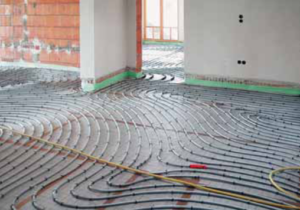
Fig. 4: Inert mass as a buffer: Specialist tradesman Freß laid underfloor heating throughout the house with a loop spacing of 10 cm (7 cm in the bathrooms). The heat pump uses the underfloor heating as a buffer and thus does not mix the sensitive stratification in the storage tank.
In addition, the company boss and development engineer designed an individual heating concept with which it was possible to achieve high solar utilisation and long heat pump runtimes at the same time. The solution lay in the clear separation of the two systems, which was the only way to do justice to both. Thus, the existing 2,000-litre buffer storage tank was made completely available for solar utilisation and only a hot zone was created in the upper area for hot water preparation via a fresh water station. For the heat pump, the underfloor heating was designed as a thermally inert mass to the buffer. For this purpose, the weather-compensated control was placed on the return flow from the building, which leads to significantly higher running times: The heat pump always runs until there is a temperature rise in the return. "The advantage in combining heat pump and underfloor heating is that both are low-temperature systems: Both have a large volume flow with a low spread and therefore fit together optimally," Baunach explains his idea. This prevents the heat pump from constantly switching on and off, which would waste energy unnecessarily.
Harmony and efficiency through clear division of tasks
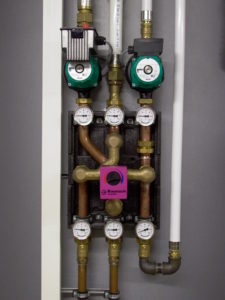
Fig. 5: The heart of the heating system: The rMIX 3 x 3 L 35 multi-way mixing manifold is the control centre of the heating system: With its help, the solar system and heat pump complement each other instead of interfering with each other's performance.
In addition to separating the two systems, it was important to ensure that there were no disturbances within the division of tasks. To prevent the heat pump from switching on while there is still sufficient solar heat in the buffer, the heating curve of the mixing circuit control was set slightly higher than that of the heat pump. As soon as the heat pump starts, the mixer is fully opened. A relay circuit prevents the mixer from closing again due to the increased flow temperature, which would lead to a reduction in volume flow and thus a high-pressure shut-off. As soon as the heat pump has switched off, the mixing circuit control of the solar system takes over the mixer control again. The mixer is closed, preventing the heat from the building buffer from reaching the solar buffer. This means that the solar heat can be stored at the lowest possible temperature level at any time, resulting in the greatest possible utilisation. In addition, a delay circuit was built into the energy controller with a so-called staircase relay, which allows the pump to run for three minutes after the hot water has been produced. During this time, the mixer can open again, as the energy controller always tries to switch the system to heating mode immediately after a phase of hot water preparation for the purpose of start minimisation.
The rendeMIX as a mediator
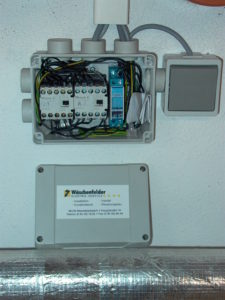
Fig. 6+7 :Clever wiring: Two relay circuits ensure controlled opening and closing of the mixer.
 The control centre of the heating system and mediator between the solar system and the heat pump is the rMIX 3 x 3 L 35 multi-way mixing manifold. The fitting was attached directly to the buffer storage tank, where it ensures ideal stratification and thus utilisation of the solar heat. The latest product from Baunach with a charging output has three inputs to the buffer storage tank, enabling optimum two-zone discharging. As long as the middle connection is still supplied by a sufficiently high temperature, the mixer does not access the upper input, in whose connection to the buffer the heat pump is located. As soon as the mixer opens to the upper input, the lower input closes and thus directs the entire return flow of the underfloor heating into the lower part of the buffer. If the middle part of the buffer is also discharged, the mixer opens fully and now draws the entire floor flow through the heat pump, which can then start. The relay circuit prevents the excessive flow temperature from causing the mixer to close. The heat pump runs until in the floor return flow from the building a temtemperature rise is measured. The subsequent re-release of the mixer closes it, keeping the heat pump heat in the building. In the subsequent cooling phase, the mixer opens again slowly, utilising every solar kWh, before it opens fully again and the cycle starts again.
The control centre of the heating system and mediator between the solar system and the heat pump is the rMIX 3 x 3 L 35 multi-way mixing manifold. The fitting was attached directly to the buffer storage tank, where it ensures ideal stratification and thus utilisation of the solar heat. The latest product from Baunach with a charging output has three inputs to the buffer storage tank, enabling optimum two-zone discharging. As long as the middle connection is still supplied by a sufficiently high temperature, the mixer does not access the upper input, in whose connection to the buffer the heat pump is located. As soon as the mixer opens to the upper input, the lower input closes and thus directs the entire return flow of the underfloor heating into the lower part of the buffer. If the middle part of the buffer is also discharged, the mixer opens fully and now draws the entire floor flow through the heat pump, which can then start. The relay circuit prevents the excessive flow temperature from causing the mixer to close. The heat pump runs until in the floor return flow from the building a temtemperature rise is measured. The subsequent re-release of the mixer closes it, keeping the heat pump heat in the building. In the subsequent cooling phase, the mixer opens again slowly, utilising every solar kWh, before it opens fully again and the cycle starts again.
A smooth partnership
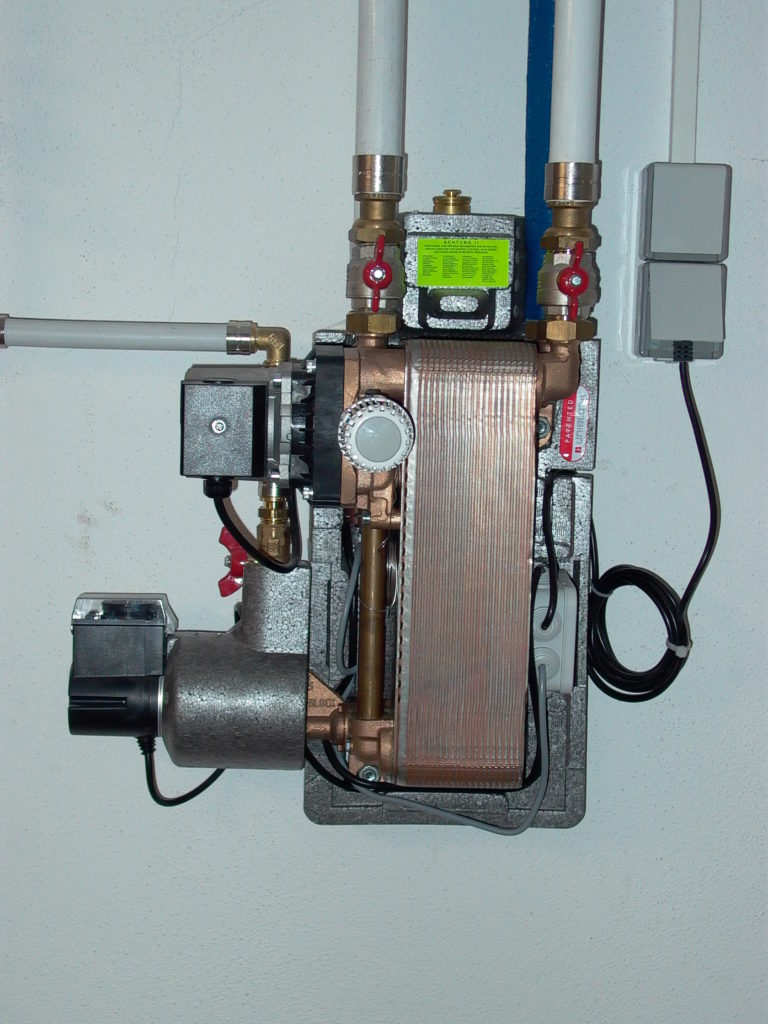
Fig. 8: Safe domestic hot water supply: A solar power fresh water module provides safety and comfort for the hot water supply. It works according to the flow-through principle: the desired amount of fresh water is heated on demand via a heat exchanger. The thermostat knob is used to set the corresponding domestic hot water temperature. (All pictures and graphics: Baunach)
"The solution is both simple and ingenious," says Freß enthusiastically. The rendeMIX makes it possible to combine any two systems and ensures an extremely efficient heating system. With the help of this multi-way mixing manifold, Freß can operate his Vaillant heat pump and the solar power solar system simultaneously without any problems. In this way, his entire house - with a heating surface of 410 square metres - is now supplied with regeneratively generated heat. When planning the required domestic water, Freß had assumed a total daily requirement of 200 litres, which are now heated by the sun from spring to autumn. A fresh water module ensures that the hot water is always fresh, thus avoiding legionella. In winter, the solar system still contributes to heating at a low temperature level. Only if the solar system cannot provide sufficient domestic hot water or floor temperature does the heat pump step in. The collector area of the solar system is large enough for this, at over 40 square metres. The rooftop collectors from the Austrian manufacturer Sonnenkraft have an optimal orientation towards the south on the 45° pitched roof and thus ensure high solar yields. The heat pump from Vaillant, type VWS 22 /1P, has a heating output of 22.6 kW. With 25 % of drive energy, it obtains the remaining 75 % from solar energy stored in the environment. The ground, groundwater and outside air are used as heat sources. In a cycle called the Carnot process, the heat extracted from the environment is raised to a higher temperature level and thus made usable for heating purposes. "My decision in favour of a heat pump was clear from the very beginning. In my opinion, it is the best and most forward-looking way to provide heating and water comfort, and it enables environmentally conscious, cost-effective heating that makes me independent of energy suppliers," Freß explains his motives.
Happy ending
Freß is extremely satisfied with the solution for his heating system: "The rendeMIX solved all my problems in one fell swoop by enabling the intelligent use of solar yields through the special hydraulic connection of the flow paths," Freß sums up. Above all, he was pleased with the comprehensive advice from Baunach, which - as he knows as an expert - is unfortunately not always a matter of course. The experts from Hückelhoven not only delivered their unique product, but also developed the entire heating concept, including a coloured hydraulic and electrical plan, talked to the manufacturer of the heat pump and convinced themselves on site of the correct functioning of the system, which has been running perfectly ever since.

Solar thermal system and heat pump together provide reliable heat supply


